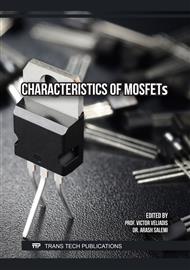[1]
J. Berens and T. Aichinger, "A straightforward electrical method to determine screening capability of GOX extrinsics in arbitrary, commercially available SiC MOSFETs," in 2021 IEEE International Reliability Physics Symposium (IRPS), Monterey, CA, USA: IEEE, Mar. 2021, p.1–5.
DOI: 10.1109/IRPS46558.2021.9405152
Google Scholar
[2]
A. K. Biswas et al., "Hole-Induced Threshold Voltage Instability Under High Positive and Negative Gate Stress in SiC MOSFETs," in 2024 IEEE International Reliability Physics Symposium (IRPS), Apr. 2024, p.1–5.
DOI: 10.1109/IRPS48228.2024.10529422
Google Scholar
[3]
F. Masin et al., "Non-monotonic threshold voltage variation in 4H-SiC metal–oxide–semiconductor field-effect transistor: Investigation and modeling," Journal of Applied Physics, vol. 130, no. 14, p.145702, Oct. 2021.
DOI: 10.1063/5.0057285
Google Scholar
[4]
D. J. DiMaria, E. Cartier, and D. Arnold, "Impact ionization, trap creation, degradation, and breakdown in silicon dioxide films on silicon," Journal of Applied Physics, vol. 73, no. 7, Art. no. 7, Apr. 1993.
DOI: 10.1063/1.352936
Google Scholar
[5]
D. Arnold, E. Cartier, and D. J. DiMaria, "Theory of high-field electron transport and impact ionization in silicon dioxide," Phys. Rev. B, vol. 49, no. 15, p.10278–10297, Apr. 1994.
DOI: 10.1103/PhysRevB.49.10278
Google Scholar
[6]
D. J. DiMaria and J. W. Stasiak, "Trap creation in silicon dioxide produced by hot electrons," Journal of Applied Physics, vol. 65, no. 6, Art. no. 6, Mar. 1989.
DOI: 10.1063/1.342824
Google Scholar
[7]
G. Groeseneken, H. E. Maes, N. Beltran, and R. F. De Keersmaecker, "A reliable approach to charge-pumping measurements in MOS transistors," IEEE Trans. Electron Devices, vol. 31, no. 1, Art. no. 1, Jan. 1984.
DOI: 10.1109/T-ED.1984.21472
Google Scholar
[8]
A. Salinaro et al., "Charge Pumping Measurements on Differently Passivated Lateral 4H-SiC MOSFETs," IEEE Trans. Electron Devices, vol. 62, no. 1, Art. no. 1, Jan. 2015.
DOI: 10.1109/TED.2014.2372874
Google Scholar
[9]
S. R. Stein, J. Kim, S. Das, D. J. Lichtenwalner, and S. Ryu, "Characterization of Interface Trap Density in SiC MOSFETs Subjected to High Voltage Gate Stress," in 2024 IEEE International Reliability Physics Symposium (IRPS), Grapevine, TX, USA: IEEE, Apr. 2024, p.1–5.
DOI: 10.1109/IRPS48228.2024.10529394
Google Scholar
[10]
P. Heremans, J. Witters, G. Groeseneken, and H. E. Maes, "Analysis of the charge pumping technique and its application for the evaluation of MOSFET degradation," IEEE Trans. Electron Devices, vol. 36, no. 7, Art. no. 7, Jul. 1989.
DOI: 10.1109/16.30938
Google Scholar
[11]
D.K. Schroder, "Negative bias temperature instability: What do we understand?," Microelectronics Reliability, vol. 47, no. 6, Art. no. 6, Jun. 2007, doi: 10.1016/j.microrel. 2006.10.006.
DOI: 10.1016/j.microrel.2006.10.006
Google Scholar
[12]
J. H. Stathis, "The physics of NBTI: What do we really know?," in 2018 IEEE International Reliability Physics Symposium (IRPS), Burlingame, CA: IEEE, Mar. 2018, p. 2A.1-1-2A.1-4.
DOI: 10.1109/IRPS.2018.8353539
Google Scholar
[13]
D. J. Lichtenwalner et al., "Reliability studies of SiC vertical power MOSFETs," in 2018 IEEE International Reliability Physics Symposium (IRPS), Burlingame, CA: IEEE, Mar. 2018, p. 2B.2-1-2B.2-6.
DOI: 10.1109/IRPS.2018.8353544
Google Scholar
[14]
R. C. Hughes, "Time-resolved hole transport in a-SiO2," Phys. Rev. B, vol. 15, no. 4, p.2012–2020, Feb. 1977.
DOI: 10.1103/PhysRevB.15.2012
Google Scholar
[15]
R. K. Chanana, "Determination of hole effective mass in SiO2 and SiC conduction band offset using Fowler–Nordheim tunneling characteristics across metal-oxide-semiconductor structures after applying oxide field corrections," Journal of Applied Physics, vol. 109, no. 10, p.104508, May 2011.
DOI: 10.1063/1.3587185
Google Scholar


